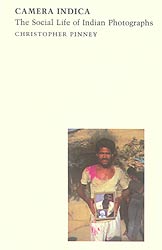PHOTO BOOKS | CAMERA INDICA
|
| PHOTO BOOKS | CAMERA INDICA |
 Camera Indica: The Social
Camera Indica: The SocialLife of Indian Photographs Christopher C. Pinney University of Chicago Press, 192 pgs., 1997 Hardback $55, Paperback $29 Christopher Pinney's Camera Indica is the first book to look at photography from its inception as an alien form in colonial times through its assimilation, a century and a half later, into the most intimate recesses of Indian tradition. Using concepts from modern literary theory - the title invokes Roland Barthes' Camera Lucida - Dr. Pinney, a Professor at the School of Oriental and African Studies in London, examines photography as it was first used to categorize and index the peoples of the subcontinent in the 19th century. He neatly describes how the British refined this moment of control into typologies and ultimately the fingerprinting of criminals. He aptly quotes the early photographer Samuel Bourne: From the earliest days of the calotype [the 1840's], the curious tripod with its mysterious chamber and mouth of brass taught the natives of this country that their conquerors were the inventors of other instruments besides the formidable guns of artillery, which, though as suspicious perhaps in appearance, attained their objects with less noise and smoke. [British Journal of Photography, 1863, p. 51]The second chapter, "Indian Eyes," takes off from Judith Gutman's pioneering Through Indian Eyes, and presents a more cogent and refined way of looking at the rise of an apparently Indian photographic tradition during the colonial period. The third chapter relies on Pinney's fieldwork as an anthropologist in two Central Indian villages to look at the photographer's art and role in the lives of villagers and town-dwellers in the 1990s. While the first two chapters are full of information and insight, Pinney hits his stride here. Personal anecdotes of photographers and consumers in action reveal how fully photography has been absorbed into the traditions of marriage, death and religion. He shows how individual and highly creative photographers develop and extend this relationship, even as modern technologies like video and color processing keep changing the idioms and demands. Camera Indica is sumptuously illustrated with 127 photographs, many in color. The text combines contemporary intellectual theory and real life examples in a way that enhances both. The result comes to grips with and yet respects the profound and elusive role photography has played in the subcontinent. One might quibble with some of the author's formulations - I for one would not agree that "by the end of the century, the 'portraiture event', with its creative unpredictability, was completely dead [p. 70]." Yet there is no doubt that this book marks the entry of an important and engaged thinker into a field typically shunned by academics. One can only hope that he continues his project to cover the new digital mediums that will further change photography as India hurtles into the 21st century. Few people are as well positioned to do so as Christopher Pinney. Order from Amazon |
| HOME | BAZAAR | © Harappa Bazaar 2002-2006 |